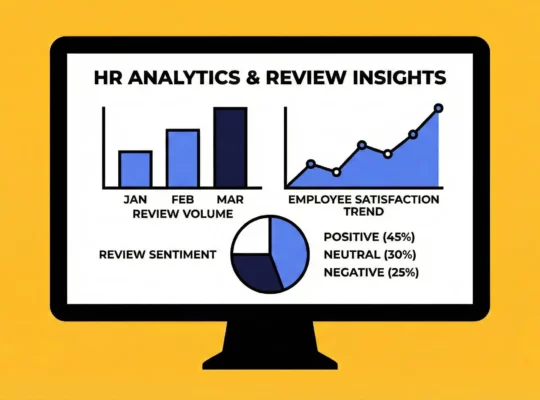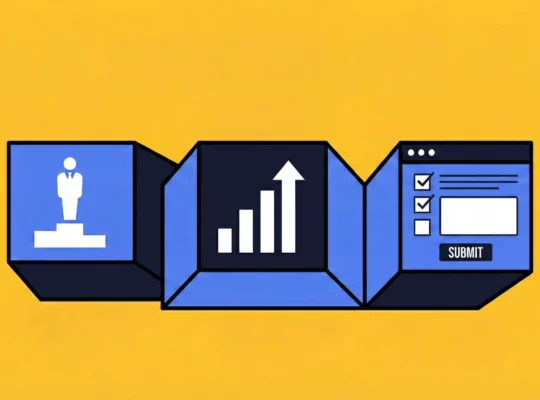Collecting anonymous reviews is a powerful way to gain honest feedback that can improve employee engagement, workplace culture, and customer satisfaction. Anonymous feedback fosters trust by protecting privacy and encouraging candid opinions, leading to actionable insights that drive meaningful change. With tools like Review.jobs, organizations can securely collect and manage anonymous employee reviews to enhance their strategies for success.
Table of Contents
- Why Anonymous Reviews Are Essential for Organizations
- How to Collect Anonymous Reviews Online
- Best Tools for Collecting Anonymous Reviews
- How to Collect Anonymous Employee Reviews with Review.jobs
- How to Encourage Anonymous Reviews
- Common Challenges in Anonymous Review Collection (and How to Overcome Them)
- Practical Tips for Success
Why Anonymous Reviews Are Essential for Organizations
Anonymous reviews have become a cornerstone for organizations seeking to cultivate a transparent and thriving workplace environment. Companies unlock a treasure trove of actionable insights by allowing employees to share their honest reviews without revealing their identities. Here’s why anonymous reviews are indispensable:
1. Eliminate Fear of Repercussions
Employees are more likely to speak freely when they know their identities are protected. Anonymity removes the fear of judgment or retaliation, enabling them to share genuine thoughts about management practices, team dynamics, and workplace policies. This candid feedback often sheds light on hidden challenges that leaders might otherwise overlook.
2. Derive Actionable Insights
Honest feedback leads to real, actionable insights. By analyzing anonymous reviews, organizations can identify trends, address recurring issues, and implement strategies to improve employee engagement. For instance, if reviews consistently highlight a lack of professional development opportunities, HR teams can introduce targeted training programs to fill the gap.
3. Create Brand Ambassadors
When employees see their feedback being acknowledged and acted upon, it builds trust in the organization’s commitment to improvement. This trust not only enhances workplace morale but also inspires employees to become advocates for the company. They’re more likely to promote the organization as a great place to work, boosting its employer brand.
How to Collect Anonymous Reviews Online
Here’s a step-by-step guide on how to collect anonymous reviews online effectively:
1. Use Reliable Tools and Platforms
Invest in trustworthy anonymous review collection tools that prioritize privacy and security. Platforms like Review.jobs are specifically tailored to manage employee reviews while ensuring anonymity. These tools often come with features such as encrypted responses and customizable surveys, making them ideal for collecting and managing employee reviews securely.
2. Communicate the Purpose and Benefits
Transparency about the intent behind collecting anonymous reviews is crucial. Explain how the insights will be used to improve workplace culture, enhance employee engagement, or address concerns. This clarity reassures employees and encourages participation by showing them that their voices matter.
3. Ensure Anonymity
To maintain confidentiality:
- Avoid asking for personally identifiable information, such as names or department details.
- Use tools that aggregate responses to prevent singling out individual contributors.
- Regularly audit data handling processes to ensure compliance with privacy standards.
4. Act on the Collected Reviews
Anonymous reviews are only as useful as the actions taken in response to it. Schedule regular reviews of the collected feedback to identify trends and prioritize improvements. Communicate these actions back to employees, showcasing that their input directly influences positive changes within the organization.
Best Tools for Collecting Anonymous Reviews
Choosing the right anonymous feedback tools is crucial for gathering honest and actionable insights from employees. Whether you’re looking for advanced analytics or simple survey functionality, the following tools offer various features to suit different organizational needs.
1. Review.jobs
- Features:
- Tailored for anonymous employee reviews.
- Offers customizable feedback forms and templates.
- Ensures complete anonymity with encrypted responses.
- Provides actionable insights to improve workplace culture.
- Best For: Organizations prioritizing employee-centric reviews with high security.
2. Google Forms
- Features:
- Free and easy-to-use survey tool.
- Allows anonymous response collection by adjusting the settings.
- Offers basic data analysis and visualizations.
- Best For: Small businesses or teams looking for a cost-effective and simple solution.
3. SurveyMonkey
- Features:
- Provides anonymous survey options and advanced templates.
- Offers detailed reporting and analytics.
- Integrates seamlessly with tools like Slack and Microsoft Teams.
- Best For: Medium-sized organizations needing robust customization and reporting features.
4. Qualtrics
- Features:
- Advanced feedback forms with conditional logic.
- Highly secure platform with enterprise-grade data privacy.
- Offers AI-driven analytics for deeper insights.
- Best For: Large organizations requiring comprehensive feedback systems with in-depth analytics.
Comparison Table: Anonymous Feedback Tools
| Tool | Pricing | Ease of Use | Security Features |
| Review.jobs | Contact for pricing | User-friendly | Encrypted responses, high anonymity |
| Google Forms | Free | Very simple | Basic (no tracking of email responses) |
| SurveyMonkey | Starting at $25/month | Moderate | Customizable privacy settings |
| Qualtrics | Contact for pricing | Advanced (learning curve) | Enterprise-grade security and compliance |
How to Collect Anonymous Employee Reviews with Review.jobs
Review.jobs offers a streamlined process to gather this valuable feedback while ensuring employee anonymity. Here’s a step-by-step guide to collecting anonymous employee reviews using Review.jobs:
1. Sign Up and Set Up Your Account
- Visit Review.jobs and create or claim your business page.
- Complete your company profile by providing relevant details to help identify your organization.
2. Customize Your Review Collection Methods
- Employee Satisfaction Surveys: Design surveys tailored to assess various aspects of employee satisfaction.
- Custom Review Collection Surveys: Create specific surveys targeting particular areas or departments within your organization.
- API Integrations: Integrate Review.jobs with your existing HR systems to automate and streamline the review collection process.
3. Ensure Anonymity and Security
- Review.jobs prioritizes employee privacy by providing secure review requests and anonymous submission options.
- Clearly communicate to employees that their reviews will remain anonymous to encourage honest and open responses.
4. Distribute Review Requests
- Utilize email invitations, QR codes, or direct links to invite employees to participate in the review process.
- Encourage participation through internal communications, emphasizing the importance of their reviews in driving positive change.
5. Monitor and Manage Collected Reviews
- Access the centralized dashboard to efficiently manage incoming reviews.
- Use features like review moderation, reporting, and labeling to organize and analyze reviews effectively.
6. Analyze Feedback and Implement Improvements
- Leverage advanced analytics to understand employee sentiment trends and identify areas for improvement.
- Develop action plans based on the insights gained to enhance workplace culture and employee satisfaction.
7. Showcase Positive Reviews
- Highlight authentic reviews on your company profile, career pages, or social media channels to attract top talent and enhance your employer brand.
How to Encourage Anonymous Reviews
Creating a culture of feedback where employees feel comfortable sharing their honest opinions is essential for fostering growth and improvement. By prioritizing anonymous communication and offering safe spaces for feedback, organizations can gain valuable insights. Here are actionable tips for encouraging honest feedback anonymously:
1. Foster a Culture of Openness and Respect
Building a workplace where employees feel valued and respected lays the foundation for open feedback. Reinforce the message that every opinion matters and encourage leaders to model open communication. When employees see that feedback—both positive and critical—is welcomed without judgment, they’re more likely to share their honest thoughts.
2. Ensure Anonymity Is Consistently Upheld
Anonymity is the cornerstone of honest feedback. Reassure employees that their identities will remain confidential, and implement secure systems to protect anonymity. For instance, using tools like anonymous surveys or platforms such as Review.jobs ensures that employees can express their views freely without fear of repercussions.
3. Provide Multiple Channels for Anonymous Feedback
Different employees may feel comfortable using different methods of communication. Offer a variety of anonymous feedback options, such as:
- Online surveys with anonymity settings.
- Physical suggestion boxes in common areas.
- Anonymous email forms or dedicated feedback apps.
By providing multiple avenues, you ensure that everyone has a way to voice their opinions.
4. Act on Feedback Promptly to Build Trust
A surefire way to encourage ongoing feedback is to show employees that their input leads to tangible results. Regularly review the feedback you receive, prioritize actionable items, and communicate the changes made based on their suggestions. For example, if employees express concerns about workload, introduce better workload management strategies and inform the team about these initiatives.
Common Challenges in Anonymous Review Collection (and How to Overcome Them)
Challenges like low response rates, concerns about anonymity, and the risk of misinterpreting reviews can hinder the effectiveness of your efforts. Here are some common challenges and practical solutions to overcome them:
Challenge 1: Low Response Rates
Why It Happens:
Employees may feel indifferent, skeptical about the purpose, or unsure if their feedback will lead to meaningful change.
Solution:
- Frequent Communication: Explain the purpose of collecting feedback and how it will be used to improve the workplace.
- Incentives: Offer small incentives, such as recognition or gift cards, to encourage participation.
- Ease of Access: Use tools like Review.jobs or other platforms with user-friendly interfaces to make providing feedback quick and seamless.
Challenge 2: Concerns About the Anonymity of Feedback
Why It Happens:
Employees may worry that their responses can be traced back to them, leading to reluctance in sharing candid opinions.
Solution:
- Reinforce Anonymity: Regularly assure employees that their identities are protected and highlight the measures in place to ensure confidentiality.
- Data Security Practices: Use secure feedback tools designed for anonymity, such as encrypted surveys or platforms with robust privacy policies.
- Transparency: Share examples of past feedback (without identifying contributors) and demonstrate how it led to actionable outcomes.
Challenge 3: Misinterpretation of Feedback
Why It Happens:
Anonymous comments can sometimes lack context or clarity, leading to misunderstandings about the intent or severity of an issue.
Solution:
- Provide Feedback Guidelines: Offer tips on how to structure feedback constructively, such as focusing on specific issues and potential solutions.
- Follow-Up Actions: When possible, use anonymous surveys that allow clarifying questions or provide categories for feedback to guide employees.
- Trained Analysis: Assign a team to review and interpret feedback objectively, ensuring insights are actionable and free from bias.
Practical Tips for Success
To ensure a smooth feedback process:
- Invest in the Right Tools: Platforms like Review.jobs offer a balance of anonymity and user-friendliness, encouraging participation while ensuring data security.
- Build a Feedback Culture: Make anonymous feedback collection a routine part of workplace communication, so employees see it as a normal and valued process.
- Act on Feedback: Share summaries of collected feedback and outline steps the organization is taking based on employee suggestions.
Anonymous reviews are a cornerstone for improving workplace culture, employee engagement, and customer satisfaction. With tools like Review.jobs, organizations can collect anonymous feedback securely, analyze valuable insights, and foster continuous improvement. Ready to enhance your feedback process? Explore Review.jobs today and transform how your organization collects and acts on anonymous reviews.





